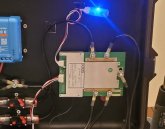SolarNewby
New Member
- Joined
- Oct 15, 2019
- Messages
- 2
I have a question and yes its probably a stupid one. The new BMS that you found will it stop charging when the cells are at full charge? I just can seem to get that thru my head. I plan to use the 4S LiFePO4 battery with BMS as a "remote" power source (no solar no full time charger) for use with my Ham Radio that draws max 41Amps during transmit at field locations. I was planning to re-charge when I get home with a standard auto charger (if this is okay)...Please give me advise below Thanks, S-N



